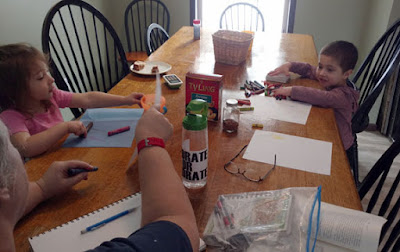I chose the title and theme long before I chose the paintings. Looking at them together in my studio, I thought, they’re oddly autobiographical.
The Camden Public Library will present “Fantastic Places and Magical Realms” on Saturday, December 11, from 1 to 3 PM. The public is invited.
When Julia Pierce asked me to hold my show over through December at the Camden Public Library, I thought, “what’s the fun in that? We might as well switch it up.” Four weeks is short notice to put together a show, but I have a secret stash of quirky paintings. They’re things I painted to amuse myself, or to think through an idea that was on my mind.
Many people commented that Welcome Back to Real Life—which I’m taking down tomorrow—was grounded in mid-coast Maine. They were easily-recognized scenes, with a sense of place. “It’s the Maine I grew up with,” said one visitor.
 |
| The Late Bus, oil on canvasboard, $435 framed. |
For this show, I wanted to get as far as possible from that reality. I was looking for themes that are common to all of us, no matter where we live. Some started as plein air paintings that went haywire along the way. Some are real places that could be anywhere. Some are the product of my own imagination.
I could have titled this show, “A look into the recesses of the cluttered cabinet I call my mind.” It’s less polished and more visceral than the work I showed last month.
My classes are focused on narrative painting right now—painting that tells a story that’s greater than mere pictorial prettiness. I tried to select work for this show that operates within that idea, although few of them actually contain figures.
 |
| Best Buds, oil on canvasboard, $1087 framed. |
Don’t expect Disney here. I’m probably the least-whimsical person in the world. Asked to do a series on Holy Week for children twenty years ago, I produced a set of Stations of the Cross that are black-and-white, gritty, blood and gore.
I’m more influenced by Renaissance genre painting. It depicts everyday life and ordinary people. But they’re never real places or real people, just stories played out in paint. They often tell a folk tale or relate a moral precept.
Thus, a shipwreck, to me, is more than just a bunch of rusty stuff strewn along a beach. It’s a fable about the inevitable end of all earthly endeavor, including my own.
 |
| Red buds and red osier, 12X16, oil on canvasboard, $1449 framed. |
But striving is built into our human character, and we have to respect that, too.
Boats often stand in for people in my painting. They’re a metaphor for our existence. They remind me of our human journey through life. They sail through all sorts of weather; they are sleek and beautiful, or stout and utilitarian. They can move effortlessly, or they can founder.
Fantastic Places and Magical Realms will open on Saturday, December 11, from 1 to 3 PM. I will be catering with candy again, and I ask—for the sake of my diet—that you eat a little more of it this time.


































